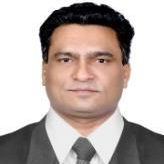
Chandresh D. Parekha
Work place: Gujarat Technological University, Ahmedabad, Gujarat, India
E-mail:
Website:
Research Interests: Computational Science and Engineering, Computational Engineering, Engineering
Biography
Chandresh Parekha (born October 21, 1972) is an academician for more than 15 years and currently serving as an Assistant Professor in Telecommunication at Raksha Shakti University, Ahmedabad, Gujarat, India. He completed B.E. (Electronics) in 1994 and M.E. (Electronics Communication System) in 2009. He also worked as an R & D engineer in Crown Television Limited, Gandhinagar, Gujarat, India and Videocon International Limited, Gandhinagar, Gujarat, India. He has been actively involved in academics by publishing more than 50 research papers in reputed journals/conferences, doing various funded research projects, delivering expert talks and organizing technical events.
Author Articles
OFDM Synchronization Techniques for 802.11ac WLAN
By Chandresh D. Parekha Jayesh M. Patel
DOI: https://doi.org/10.5815/ijwmt.2018.04.01, Pub. Date: 8 Jul. 2018
It would be dire need of accurate and fast wireless communication in the present as well as future era. Few years ago, error free wireless link design was only challenge and it had opened a way of digital communication. Now speed of communication becomes vital and essential part of research in the field of wireless communication. In wired communication category, optical communication is a solution to achieve targeted data speed but wireless channel for serial communication is highly disturbed with the phenomena of multipath and frequency selective fading for a data rate over a specific limit. A new technology named Orthogonal Frequency Division Multiplexing (OFDM) is a perfect key to open this locking situation of limited data rate with optimum use of bandwidth in the multipath fading channel. Supporting high data rates and robust response against narrowband interferences, OFDM had penetrated itself in many broadband wireless services. There are many issues with OFDM too and one of them is synchronization between orthogonal frequency channels at receiver. It is mandatory condition in the use of OFDM technology to maintain orthogonality among subcarriers for error free communication. Timing and frequency synchronization errors are quite detrimental to this condition because these errors ultimately disturb the orthogonality which is perfectly set at transmitter. Synchronization errors need to be handled properly otherwise they create Inter-Symbol Interference (ISI) and Inter-Channel Interference (ICI) which after all resulted into the deterioration of Bit Error Rate (BER). This paper covers types of synchronization and its effects, algorithms to decrease it and analysis of the same.
[...] Read more.Other Articles
Subscribe to receive issue release notifications and newsletters from MECS Press journals